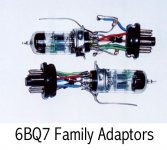Yes, output stage could be low mu triodes or pentodes with cathode feedback.Aha, it's to drive an output stage (with cathode feedback ?)
Yes, but the load resistance is still higher then I can apply in a classical way.But this way you are loading the anodes with the output resistance.Not much benefite anymore of the mosfet at the anodes.
Actually, I did some more simulating with output taken from FET sources and found that with the simulation models I'm using, ideal load of the second stage at given operating point is about 100k.
After reducing R15 and R22 to 100k, distortion with output from sources dropped to similar level as in the original post.
It will be interesting to see real world behavior here..
It would be a welcome simplification, but in simulation, distortion rose to above 1%.Since you drive the second stage with a symetrical signal the CCS at the cathodes can be replaced with a simple resistor,the sum of the two currents is a constant.
Mona
What are you doing with the pentode half of the PCL84 tubes? Leaving unused?
The pentodes are used in second stage, triode strapped.
(I used a triode-strapped pentode model, hence the triode symbol in the schematic)
The junction R7-R8 must be decoupled.Without that the anodes are coupled via C5-R15-R22-C6.Also represent an aditional load.Actually, I did some more simulating with output taken from FET sources and found that with the simulation models I'm using, ideal load of the second stage at given operating point is about 100k.
After reducing R15 and R22 to 100k, distortion with output from sources dropped to similar level as in the original post.
Even more if you change the 470k to 100k.
Mona
Why must it be decoupled in your opinion? The reason I placed C9, C10 in the original schematic was only for PSRR.The junction R7-R8 must be decoupled.Without that the anodes are coupled via C5-R15-R22-C6.Also represent an aditional load.
Even more if you change the 470k to 100k.
Mona
Upon comparison with the waveforms, it appears you are right!Isn't is Vpeak not Vrms ?
A Comparison
In hardware of course. These are the actual test results on the driver used in my version of Norman Crowhurst's Twin Coupled Amplifier. All of this has been on DIY before, for some nothing new. The driver is a 2-stage diff amp, 6SL7/6SN7, the 2nd stage boot strapped to the output. So THD measured by an HP 334A & Harmonics by a Pico Technology Scope/SA. For the fully diff amp vers the tails go thru a resister to -150 Volts.
For comparison a pair of 6BQ7's were mounted on adapters. The results obtained with the 6BQ7s are much better than I had anticipated. And no SS devices used at all.🙂
In hardware of course. These are the actual test results on the driver used in my version of Norman Crowhurst's Twin Coupled Amplifier. All of this has been on DIY before, for some nothing new. The driver is a 2-stage diff amp, 6SL7/6SN7, the 2nd stage boot strapped to the output. So THD measured by an HP 334A & Harmonics by a Pico Technology Scope/SA. For the fully diff amp vers the tails go thru a resister to -150 Volts.
For comparison a pair of 6BQ7's were mounted on adapters. The results obtained with the 6BQ7s are much better than I had anticipated. And no SS devices used at all.🙂
Attachments
In both cases R15 and R22 are a load on the anode but without decoupling there is also coupling between the anodes.A resistor at the cathodes and not the CCS (also a sort of coupling between the two tubes) made things worse I suposed the same bad result by coupling the anodes.Why must it be decoupled in your opinion? The reason I placed C9, C10 in the original schematic was only for PSRR.
Result of the non linear transfer of triodes.
Mona
Last edited:
Why? The transistors provide only constant currents.I think it's a transistor amp
Why you need two different types of gyrator transistors? DNL150 on both stages is not good?
LND150 can't handle the dissipation required for the second stage.
Say we have about 200V at 7,5mA, we need to dissipate 1,5W.
Great you say, the SOT-89 can dissipate 1,6 W!
But this figure is at 25°C ambient, we need to derate it and have no margin left..
Also, the SOT-89 package seems inconvenient without a dedicated PCB.
BR,
I am very grateful for introducing this fabulous transistor the LDN150. Look what can be done with it. Blameless Audiophile 75W amplifier.
If used a pair in differential, it gives extremely low distortion.
If used a pair in differential, it gives extremely low distortion.
- Home
- Amplifiers
- Tubes / Valves
- ECL84 as differential push pull driver

